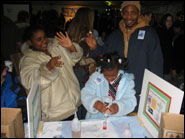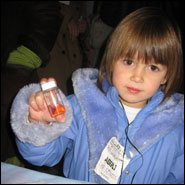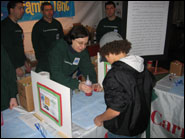|
|
||||||||
|
|
Green Chemistry a Hit at Pittsburgh's First Night Celebration
The girl was one of about 1,000 visitors who had fun conducting a Carnegie Mellon-designed green chemistry experiment as part of the downtown revelry, presented by the Pittsburgh Cultural Trust with the Three River's Arts Festival. The experiment, based on the green chemistry research developed at the Institute for Green Oxidation Chemistry, wowed hundreds of kids and their parents.
"We couldn't have been happier to have the green chemistry experiment for First Night. It was the hit of the night," said Lindsay Clark, family programs coordinator for First Night. "Hopefully, this experiment sparked a love of science in all the kids who participated."
Leading this initiative was Colin Horwitz, research professor of chemistry. Horwitz corralled numerous dedicated individuals to help. These included seven graduate students, a post-doc, five faculty (including a visiting faculty member) and their children, a technology transfer specialist and his wife, as well as local scientists with Lanxess and PPG Industries.
"Colin has led us all perfectly in showing green chemistry and our Fe-TAML® technology off to the children and parents of Pittsburgh," said Terry Collins, the Thomas Lord Professor of Chemistry and developer of the Fe-TAML technology used in the experiment. "The team of people helping at First Night presented a genuinely warm and positive image of our communal endeavors to building a sustainable civilization," added Collins, director of the Institute for Green Oxidation Chemistry in the Mellon College of Science.
The children and parents conducted a simple experiment showing how the chemical reagent Fe-TAML combined with another natural, safe chemical -- hydrogen peroxide -- could be used to clean water, just as the Carnegie Mellon chemists are doing in the laboratory and in field tests with various industries.
The revolutionary Fe-TAML technology was developed over the course of 20 years in response to a complex problem -- water pollution. Dangerous, pervasive chemicals build up in water used for drinking, swimming, agriculture and industrial processes. Just a small amount of Fe-TAMLs can destroy bad chemicals produced by different industries. Fe-TAMLs work by turbocharging hydrogen peroxide to achieve their phenomenal results.
Fe-TAMLs are one of the most promising green chemistry solutions in development to rid water of unsightly, unhealthy chemicals. And because they help some industries become cleaner, they should help companies produce better materials more cheaply and with less waste.
The night was so successful that visitors from the University of Nottingham in the U.K. emailed Colin later requesting information on how to do something similar for the public near their university.
"The bottom line is that Fe-TAMLs may help our environment win against more than 100 years of pollution that we need to fix," said Horwitz.
It's this green legacy he wants to leave his own two sons, who were busy experimenting that night.
Lauren Ward |
||||||
|
Carnegie Mellon Home |
||||||||


